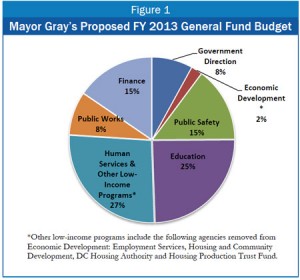On March 23rd, Mayor Gray submitted his budget proposal for fiscal year 2013, which starts October 1, 2012. The proposed general fund budget ‘ the portion of the DC budget that comes from local taxes and fees, including dedicated tax revenue and special purpose funds ‘ is $6.75 billion.[1] When federal funding for programs and services is included’in what is called gross funds’the District’s fiscal year (FY) 2013 budget is $9.9 billion. 
Mayor Gray’s proposed FY 2013 general fund budget is about $209 million higher than the approved FY 2012 budget, after adjusting for inflation ‘ an increase of 3 percent. (Unless otherwise noted, all figures in this analysis are adjusted for inflation to equal FY 2013 dollars.) The boost in local spending is due to several large factors: increasing Medicaid costs, rising enrollment and costs in public schools, an uptick in repayments of debt issued for construction projects, and the need to replace federal dollars that were available in FY 2012 but will not be available in FY 2013.
This report reviews the key elements of the proposed FY 2013 budget. As Mayor Gray worked to develop a budget proposal, the city faced an estimated gap of $172 million between expected tax revenues and anticipated expenditures to maintain city services. In order to close the gap, Gray proposed a package that includes both new revenue initiatives and spending reductions. Reductions in agencies came from discussion with agencies as well as from Mayor Gray’s One City Performance Review, a top-to-bottom analysis of the DC budget led by former DC Chief Technology Officer Suzanne Peck. It is unclear how much came from the performance review, because the report has not been released to the public.
The District’s revenue collections in FY 2013 will total $6.7 billion, if the Mayor’s revenue initiatives in his proposed budget are adopted. The District’s tax collections dropped sharply in the Great Recession, starting in FY 2009 and have only recently recovered. FY 2013 revenue, with the inclusion of Gray’s initiatives, will still be slightly lower than those in FY 2008, the final year before the recession hit. A full discussion of the proposed revenue initiatives occurs below.
As part of his budget request, Mayor Gray also included a 25-item “Revised Revenue Estimate Contingency Priority List.” This list, totaling approximately $120 million, would provide funding for programs if more revenue is projected over the fiscal year. Items are arranged in numerical order, and the programs would be funded in order as additional revenues are added. Most of the programs and services that would have funding reductions in Gray’s proposed budget are included in the list. The top three include restoring $7 million in homeless services funds that would be cut due to federal grant reductions; adding $14.7 million to job training and related assistance for families on public assistance; and $23 million to keep in place hospitalization benefits for DC’s locally-funded healthcare program. The complete list, in order, can be found in the appendix.
The proposed FY 2013 budget continues the trend since the recession began of making investments in education, and there are also significant proposed investments in public works and economic development. Some human services programs would also see an increase. But others, including services that provide health care and affordable housing, would continue to experience deep cuts. For the second year in a row, Gray proposed taking a large share of funding from the Housing Production Trust Fund, DC’s main source of financing to build and preserve affordable housing. A continued lack of affordable housing makes it difficult for low-and-moderate income families to make ends meet, and that financial pressure can have long-term costs and repercussions that might cause a decline in quality of life for District residents.
This analysis is part of an online “Budget Toolkit” developed each year by the DC Fiscal Policy Institute, which can be found at www.dcfpi.org.
To read the full report, click here.
[1] The general fund budget includes the “local funds budget” — programs and services supported by taxes and fees collected by the District ‘ as well as services supported by “special purpose” revenues or “dedicated taxes.” This analysis does not include the enterprise appropriation and keeps several dedicated funds within finance instead of enterprise so year-to-year comparisons can be made.
